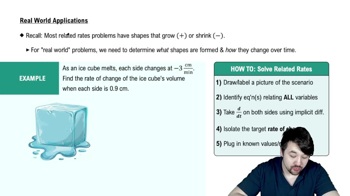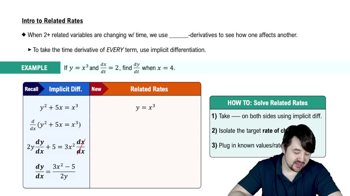Table of contents
- 0. Functions7h 52m
- Introduction to Functions16m
- Piecewise Functions10m
- Properties of Functions9m
- Common Functions1h 8m
- Transformations5m
- Combining Functions27m
- Exponent rules32m
- Exponential Functions28m
- Logarithmic Functions24m
- Properties of Logarithms34m
- Exponential & Logarithmic Equations35m
- Introduction to Trigonometric Functions38m
- Graphs of Trigonometric Functions44m
- Trigonometric Identities47m
- Inverse Trigonometric Functions48m
- 1. Limits and Continuity2h 2m
- 2. Intro to Derivatives1h 33m
- 3. Techniques of Differentiation3h 18m
- 4. Applications of Derivatives2h 38m
- 5. Graphical Applications of Derivatives6h 2m
- 6. Derivatives of Inverse, Exponential, & Logarithmic Functions2h 37m
- 7. Antiderivatives & Indefinite Integrals1h 26m
- 8. Definite Integrals3h 25m
4. Applications of Derivatives
Related Rates
Problem 3.11.42
Textbook Question
A 12-ft ladder is leaning against a vertical wall when Jack begins pulling the foot of the ladder away from the wall at a rate of 0.2 ft/s. What is the configuration of the ladder at the instant when the vertical speed of the top of the ladder equals the horizontal speed of the foot of the ladder?
 Verified step by step guidance
Verified step by step guidance1
Identify the relationship between the lengths of the ladder, the height of the top of the ladder on the wall (y), and the distance from the wall to the foot of the ladder (x) using the Pythagorean theorem: x^2 + y^2 = 12^2.
Differentiate the Pythagorean theorem equation with respect to time to relate the rates of change of x and y: 2x(dx/dt) + 2y(dy/dt) = 0.
Substitute the known rate of change for the foot of the ladder (dx/dt = 0.2 ft/s) into the differentiated equation to express dy/dt in terms of x and y.
Set dy/dt equal to dx/dt (0.2 ft/s) to find the specific configuration of the ladder when the vertical speed equals the horizontal speed.
Solve the resulting equations to find the values of x and y at the instant when the speeds are equal, ensuring to check that the values satisfy the original Pythagorean theorem.
Recommended similar problem, with video answer:
 Verified Solution
Verified SolutionThis video solution was recommended by our tutors as helpful for the problem above
Video duration:
5mPlay a video:
Was this helpful?
Related Videos
Related Practice






